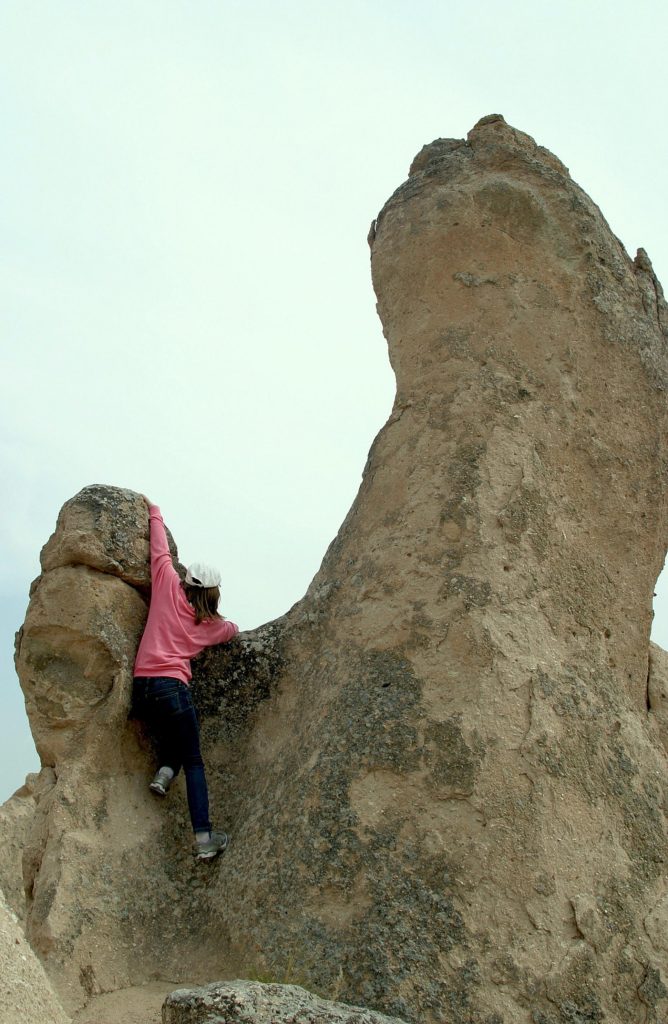In Angela’s dreams, there was always a similar theme. In them, she was climbing a mountain, an impossibly-steep slope that seemed to tower ever-higher so that no matter how hard she tried, she could never get to the top. Sometimes she met obstacles, weather, darkness, various elements that hindered her journey. Then one day, the way opened up. It was wide and clear, she felt strong and capable, with an inner conviction she would make it to the summit. This dream heralded a dramatic shift: an increase in agency in her dreaming life that was paralleled in her waking life. Recent research has shown this correlation is not unique to Angela. In fact, the ongoing pattern of dream life of clients in psychotherapy provides important diagnostic and prognostic information.
Nightmare treatment brings predictable shifts in dreaming patterns
In my doctoral research, my qualitative study of the way dreams changed for refugees with PTSD nightmares following dream therapy unearthed a promising pattern across cases. In these harrowing recurrent nightmares, the dream ego’s plight was always dire, the dreamer felt helpless, and would typically wake up in the most frightening part of the dream, about to be killed, kidnapped or in some way deeply traumatized. In the dreamwork, we invited them to imagine a new dream ending, and after this, the dream ego in subsequent dreams showed progressively more agency. In the dreams, the dream ego moved in reverse order of the nervous system’s response to threat: from freeze to flight to fight. Coinciding with this was a significant reduction in PTSD symptoms.
Study identifies the four most common dream patterns
A recent study of dream patterns as related to the psychotherapy process confirms this general progression. The researchers found that dreams generally follow one of the four most common patterns. In the first, the dream ego is threatened; second, the dream ego is confronted with a task or performance requirement; third is a mobility dream depicting some kind of journey; and fourth is a social interaction dream. Any of these patterns can get stuck in a repetitive pattern that the researchers found would coincide with some form of pathology. When the dream begins to shift, so does the dreamer.
For the study led by Roesler (2018), researchers analysed 202 dreams of 15 patients in psychoanalytic therapy and found that their patterns of dreaming corresponded closely with their psychological problems. For example when the dream ego is continually threatened, this corresponds with a weak ego structure, and as both the course of therapy and dreaming progressed, there was a noticeable growth in ego strength in both dreaming and waking life. For example, instead of trying to escape the threat, the dream ego might confront the threatening figures or actively fight, and ultimately succeed, or the threat itself transforms into something less dangerous For example, “In Case 5, in the first half of the series, the dream ego is threatened by snakes. Then in the midst of the dream series, a golden snake appears which is not dangerous” (p. 313). The author noted that these patterns of transformation occurred only in the cases where the therapist reported improvement in both symptoms and personality structure.
As dream ego becomes stronger, so does the dreamer
The relationship between dream patterns and the dreamer’s psychological health tended to move forward in predictable ways, and the patterns themselves formed a kind of continuum: dreams of a threatened dream ego would shift toward more engaged and empowered patterns such as journeys or social interactions. In general, an active dream ego with the ability to solve problems and exhibit agency correlates with psychological health in waking life.
What does this mean for therapists? The study demonstrates two good reasons to track and work with client’s dreams. First, the dreams provide diagnostic information and can indicate clinical progress. Second, working with the dreams themselves may be able to bring about the very changes the client seeking therapy is needing.
Dreams provide honest feedback to therapists
Jenkins (2014) conceives of dreamwork as an intervention in the dream life of the client. If it is effective, the dream life changes for the better. He wrote that “the dream work can then be judged by its influence on the next dream.” This gives the dream worker immediate feedback that is unfiltered: “It allows for an independent assessment rather than relying in the self-assessment of the dreamer.”
To return to Angela’s dream, the sudden shift in the dramatic landscape to something far less daunting, and her corresponding increase in agency and confidence could be viewed as a sign of success not just in the dream, but in the therapy process and in her life. Dream work that invites experiential connection with the dream to foster such shifts may be helpful not only in dream life, but in life in general, and the subsequent dreams can provide proof of success. If Angela next dreams of leading a successful expedition to the Everest summit, we know she is going to be just fine.
Jenkins, D. (2014). Assessing dream work: Conceptualizing dream work as an intervention in dream life. International Journal of Dream Research, 7(2), 121-128.
Roesler, C. (2018). Dream Content Corresponds with Dreamer’s Psychological Problems and Personality Structure and with Improvement in Psychotherapy: A typology of Dream Patterns in Dream Series of Patients in Analytical Psychology. Dreaming, 28(4), 303-321.

